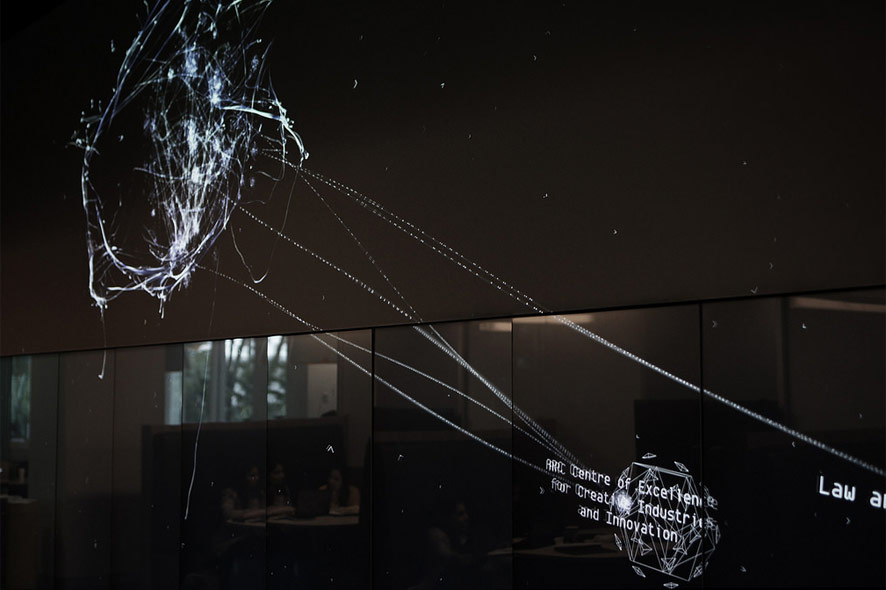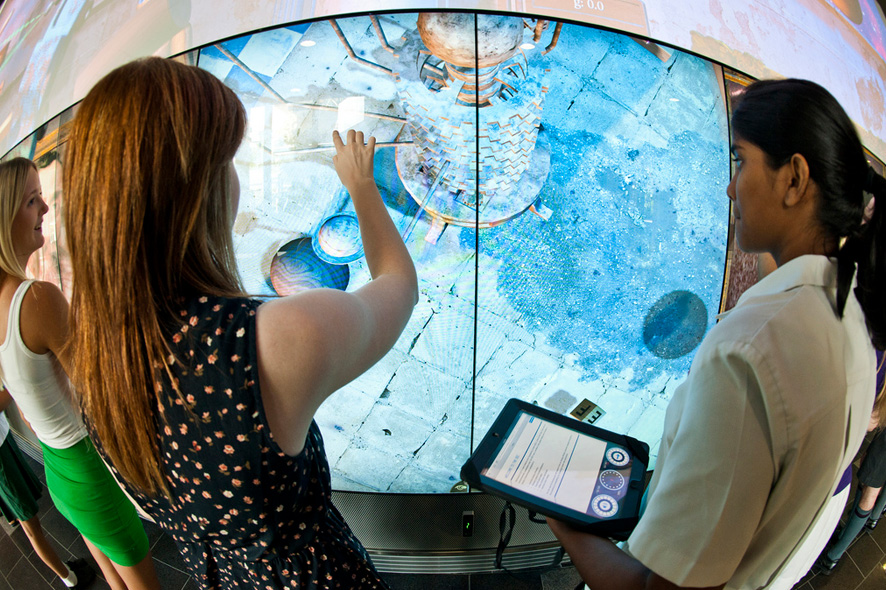Breathing life into the soul of the university organism calls for the creation of a fictional character. At the new Science and Engineering Center of Queensland University of Technology (QUT), it’s called “Soul of the Cube,” a virtual creature that’s emerged from a full year of project work and is now appearing on a high-end display called The Cube. The challenge of taking an interaction display that had previously been used strictly for teaching purposes and putting it to artistic use was taken up by Peter Holzkorn, a project director at the Ars Electronica Futurelab. In this interview, he describes the problems of bringing forth a virtual being, and what looking into a campus’ soul reveals.
“Soul of the Cube” sounds like the title of a sci-fi film. So, tell us about this project bearing a name suggestive of the realm of fantasy: what’s its connection to the real world?
Peter Holzkorn: In light of the fact that the fictional character appears on one of the world’s largest digital interactive learning & presentation displays, this obviously is a show of jumbo dimensions. Nevertheless, this figure lives on hard facts. Even the depiction of the organism seems fantastic. The origin of the idea that led up to the “Soul of the Cube” project was to come up with a technically enhanced and artistically appealing application of The Cube. Thus, calling this a spinoff like in the case of a film sequel isn’t far-fetched at all. Providing access to this huge piece of infrastructure with its interior display controlled by 12 processors and with an exterior display split into four sectors, each controlled by up to seven processors, was originally primarily for didactic purposes. It enabled visitors to the Science and Engineering Center to use various applications in order to visualize scientific content in an optically appealing way.
The idea of utilizing it to display art and for game playing is based on the intention of modifying how data are perceived by means of alternative modes of depiction. In other words, collecting and interlinking data to create a fictional being that we’ve dubbed “The Soul” is a means to a creative end. The Ars Electronica Futurelab was commissioned to do the visualization, while the QUT staff enhanced the technical performance of the applications running separately from each other.

Peter Holzkorn, Horst Hörtner and Michael Platz from the Ars Electronica Futurelab in front of The Cube in Brisbane, Credit: Sonja de Sterke
What were the specific challenges, both the technical as well as the artistic aspects?
Peter Holzkorn: Since, in everyday operation, the applications were stopped and started manually, there was often a black screen on the display. In addition to handling scheduling tasks and the smooth transition between the applications’ start & stop phases, QUT also assumed responsibility for developing the applications, which were to be designed to provide an ever-changing lineup of developers with a simplified approach to the programming process. Once QUT established that most Resident Artists had previously worked with the Unity game engine, there was a strong incentive to use a Unity framework. So they wrote a customized plug-in especially for the development environment.
“By expanding a game engine that’s normally designed for multiplayer games, QUT achieved quick interaction among the processors and mastered the challenge of picture screen synchronization.”
Since the fictional character appears for the purpose of harmonizing the transition between the applications’ starts and stops, the Futurelab’s task was to find and map data that would endow the character with a soul and impart to it a look that expressed the prevailing attitude. In other words, on the basis of a variety of data, we sought to identify possible mood patterns that could be derived from the behavior of campus visitors. So much for the challenge!
What data sources did you partake of and why?
Peter Holzkorn: Basically speaking, we made use of two data pools that came into consideration as being correlated to behavioral patterns. Since the building housing the new Science and Engineering Center was constructed with sustainable use in mind, usage data make it possible to draw conclusions about the level and type of activity of campus visitors. Thus, statistics detailing water, gas and energy use are indicators of the motivation of users.
The second major data source that we drew upon to generate a mood profile is the ePrints database containing approximately 72,000 research publications that are available on demand and can be instantaneously downloaded—some more than others. These numbers of views provide information about the department to which they’re being downloaded—that is to say, the actors—as well as about the importance of a document based on how often it’s accessed. But this also says something about the varying interest in particular subjects. The next step was to find a metaphor for the simulation of a creature that changes its form and color depending on the mapping of the behavioral pattern.

Credit: QUT Cube Studio
So, how did you ultimately come up with the design of this virtual being “The Soul of the Cube”?
Peter Holzkorn: After having considered several visual approaches, we decided on an organic textile structure. The skeleton that gives the creature its structure results from interlinkages among the data from the research network—for example, author, college, department, etc. The predefined mood parameters are ascertained from the intensity of the data flow determined on the basis of usage statistics. This means that the more a resource is used, the more intensive are the movements and, depending on what’s in demand, the intensity of the color is stronger or weaker.
So-called mood mapping is an assumed correlation between data flows and predefined mood parameters such as liveliness, nervousness and attentiveness. Accordingly, there’s a direct relationship between the frequency of a system start and the collective emotional state, the feelings on campus. An exemplary source of inspiration for this approach is “ZeitRaum” (TimeSpace), an art installation at Vienna International Airport’s newest terminal, where mapping of departure & arrival times with flight destination is used to generate a modified landscape.

Students working at the touchscreens of The Cube, Credit: QUT
How were the touchscreens that visitors use for game-playing and educational purposes integrated into the concept of the virtual creature?
Peter Holzkorn: This element was hard to work in due to the concept as I originally described it. Ultimately, we decided to enable visitors to assert a modicum of influence on the current frame of mind during the period of time when “The Soul” appears. Its skeleton is made up of junctions or hubs, and touching the touchscreen causes the appearance of these so-called nodes, which are accepted into the organism. This simulation is meant to express that the soul leads an independent existence to a certain degree. However, there’s no connection between the type of touch and the mood on campus, since “The Soul” doesn’t recognize the difference between knocking and stroking. And when it all gets to be too much, it might not react at all—but each and every one of us knows that we’ve done the same thing a time or two ourselves!

Peter Holzkorn is a researcher/artist at the Ars Electronica Futurelab. After studying computer science and interactive art in Vienna and New York, he joined the Futurelab in 2011, where he has been focusing on the design and implementation of software systems for distributed sound and graphics, often involving sensor systems and data-driven, generative content. The projects he has contributed to include large-scale media art installations (ZeitRaum), UAV swarm control systems (Spaxels), experimental audio games (Audioversum) and data-driven art (Soul of the Cube). He also coordinates activity for the Ars Electronica Futurelab Academy, a framework for knowledge transfer with universities and organizations in related fields.
